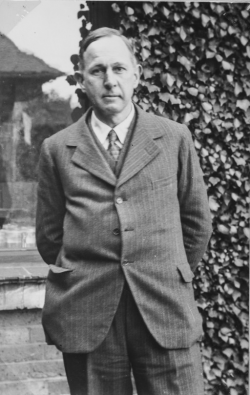Dr Carrington Bonsor Williams

Image from John Innes Archives courtesy of the John Innes Foundation
- Born
- 7 October 1889
- Died
- 12 July 1981 (age 91)
Carrington Bonsor Williams, more commonly known as CB Williams, was a leading statistical naturalist and a pioneer in measuring diversity related to ecological complexity. He was associated with insect migration, statistical ecology and biogeography.
Williams’ fascination with the insect world began at the age of 12, when a local doctor introduced him and his sister to caterpillars, while on holiday in Beddgelert in Wales. The young Williams then joined the Lancashire and Cheshire Entomological Society, which was full of, as he thought, old men all over the age of 20. He found out some years later that the members were rather surprised when they discovered the youthful age of their newest member, thinking they had voted for his father to join them instead.
Williams went on to study agriculture at Cambridge and came into contact with William Bateson who was studying caterpillars. When Williams graduated, Bateson had been appointed director of the John Innes Horticultural Institution and Williams got a research scholarship there in applied entomology.
During the First World War, Williams studied at the London School of Tropical Medicine where he examined the stools of dysentery patients and identified pathogenic bacteria. After the war, he travelled widely for work. While he was studying a pest of sugar cane in the West Indies he saw his first migration of thousands of yellow Pierid butterflies in British Guyana (now Guyana).
He returned to England in 1921 and worked for the Entomological Section of Egypt’s Ministry of Agriculture. He studied further insect migration there as applied to economic entomology and then became a government entomologist in Tanzania. While there, he saw a locust invasion that brought trains to a standstill.
A leading field and statistical naturalist of his time
For more than twenty years Williams headed the Entomology Department at Rothamsted and became the leading authority on butterfly migrations. He made numerous observations of butterfly migrations in the Tropics and had colleagues all over the world making observations for him as well.
During his time at Rothamsted, he worked with R A Fisher and studied quantitative aspects of insect populations. He became a pioneer of the statistical study of biodiversity patterns, publishing a book in 1964, Patterns in the Balance of Nature.
Williams and Fisher established the patterns and diversity of insects caught in light traps and noted that logarithmic patterns were universal. These ideas were later developed by ecologists such as Frank W Preston.
Williams was president of a number of learned societies, including the Association of Applied Biologists, the British Ecological Scoiety and Royal Entomological Society of London. He was also a Fellow of the Royal Society.



